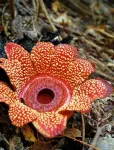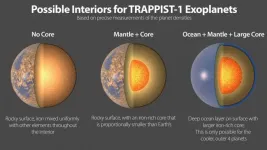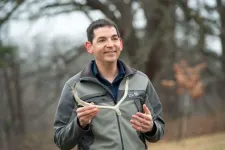(Press-News.org) UPTON, NY - New results from an atmospheric study over the Eastern North Atlantic reveal that tiny aerosol particles that seed the formation of clouds can form out of next to nothingness over the open ocean. This "new particle formation" occurs when sunlight reacts with molecules of trace gases in the marine boundary layer, the atmosphere within about the first kilometer above Earth's surface. The findings, published in the journal Nature Communications, will improve how aerosols and clouds are represented in models that describe Earth's climate so scientists can understand how the particles--and the processes that control them--might have affected the planet's past and present, and make better predictions about the future.
"When we say 'new particle formation,' we're talking about individual gas molecules, sometimes just a few atoms in size, reacting with sunlight," said study co-author Chongai Kuang, a member of the Environmental and Climate Sciences Department at the U.S. Department of Energy's Brookhaven National Laboratory. "It's interesting to think about how something of that scale can have such an impact on our climate--on how much energy gets reflected or trapped in our atmosphere," he said.
But modeling the details of how aerosol particles form and grow, and how water molecules condense on them to become cloud droplets and clouds, while taking into consideration how different aerosol properties (e.g., their size, number, and spatial distribution) affect those processes is extremely complex--especially if you don't know where all the aerosols are coming from. So a team of scientists from Brookhaven and collaborators in atmospheric research around the world set out to collect data in a relatively pristine ocean environment. In that setting, they expected the concentration of trace gases to be low and the formation of clouds to be particularly sensitive to aerosol properties--an ideal "laboratory" for disentangling the complex interactions.
"This was an experiment that really leveraged broad and collaborative expertise at Brookhaven in aerosol observations and cloud observations," Kuang said. Three of the lead researchers--lead authors Guangjie Zheng and Yang Wang, and Jian Wang, principal investigator of the Aerosol and Cloud Experiments in the Eastern North Atlantic (ACE-ENA) campaign--began their involvement with the project while working at Brookhaven and have remained close collaborators with the Lab since moving to Washington University in St. Louis in 2018.
Land and sea
The study made use of a long-term ground-based sampling station on Graciosa Island in the Azores (an archipelago 850 miles west of continental Portugal) and a Gulfstream-1 aircraft outfitted with 55 atmospheric instrument systems to take measurements at different altitudes over the island and out at sea. Both the ground station and aircraft belong to the DOE Office of Science's Atmospheric Radiation Measurement (ARM) user facility, managed and operated by a consortium of nine DOE national laboratories.
The team flew the aircraft on "porpoise flights," ascending and descending through the boundary layer to get vertical profiles of the particles and precursor gas molecules present at different altitudes. And they coordinated these flights with measurements taken from the ground station.
The scientists hadn't expected new particle formation to be happening in the boundary layer in this environment because they expected the concentration of the critical precursor trace gases would be too low.
"But there were particles that we measured at the surface that were larger than newly formed particles, and we just didn't know where they came from," Kuang said.
The aircraft measurements gave them their answer.
"This aircraft had very specific flight patterns during the measurement campaign," Kuang said. "They saw evidence that new particle formation was happening aloft--not at the surface but in the upper boundary layer." The evidence included a combination of elevated concentrations of small particles, low concentrations of pre-existing aerosol surface area, and clear signs that reactive trace gases such as dimethyl sulfide were being transported vertically--along with atmospheric conditions favorable for those gases to react with sunlight.
"Then, once these aerosol particles form, they attract additional gas molecules, which condense and cause the particles to grow to around 80-90 nanometers in diameter. These larger particles then get transported downward--and that's what we're measuring at the surface," Kuang said.
"The surface measurements plus the aircraft measurements give us a really good spatial sense of the aerosol processes that are happening," he noted.
At a certain size, the particles grow large enough to attract water vapor, which condenses to form cloud droplets, and eventually clouds.
Both the individual aerosol particles suspended in the atmosphere and the clouds they ultimately form can reflect and/or absorb sunlight and affect Earth's temperature, Kuang explained.
Study implications
So now that the scientists know new aerosol particles are forming over the open ocean, what can they do with that information?
"We'll take this knowledge of what is happening and make sure this process is captured in simulations of Earth's climate system," Kuang said.
Another important question: "If this is such a clean environment, then where are all these precursor gases coming from?" Kuang asked. "There are some important precursor gases generated by biological activity in the ocean (e.g., dimethyl sulfide) that may also lead to new particle formation. That can be a nice follow-on study to this one--exploring those sources."
Understanding the fate of biogenic gases such as dimethyl sulfide, which is a very important source of sulfur in the atmosphere, is key to improving scientists' ability to predict how changes in ocean productivity will affect aerosol formation and, by extension, climate.
INFORMATION:
The research was funded by the DOE Office of Science, DOE's Atmospheric System Research, and by NASA. In addition to the researchers from Brookhaven Lab and Washington University, the collaboration included scientists from Pacific Northwest National Laboratory; Missouri University of Science and Technology; the University of Washington, Seattle; NASA Langley Research Center; Science Systems and Applications Inc. in Hampton, Virginia; the Max Planck Institute for Chemistry in Mainz, Germany; and the Scripps Institution of Oceanography, University of California, San Diego.
Brookhaven National Laboratory is supported by the Office of Science of the U.S. Department of Energy. The Office of Science is the single largest supporter of basic research in the physical sciences in the United States, and is working to address some of the most pressing challenges of our time. For more information, please visit science.energy.gov.
Follow @BrookhavenLab on Twitter or find us on Facebook.
Related Links
Online version of this news release with photos and graphics
Scientific paper: "New particle formation in the remote marine boundary layer"
Media Contacts
Karen McNulty Walsh [mailto:kmcnulty@bnl.gov], (631) 344-8350, or Peter Genzer [mailto:genzer@bnl.gov], (631) 344-3174
Millions of students around the world could benefit if their educators adopted a more flexible and practical approach, say Swansea University experts.
After analysing the techniques current being used in higher education, the researchers are calling for a pragmatic and evidence-based approach instead.
Professor Phil Newton, director of learning and teaching at of Swansea University Medical School, said: "Higher education is how we train those who carry out important professional roles in our society. There are now more than 200 million students in HE worldwide and this number is likely to double again over the next decade.
"Given the size, impact, importance and cost of ...
Researchers at the Consejo Nacional de Investigaciones Científicas y Técnicas (CONICET) in Argentina have found that, since the 1990s, up to 25% of reported bee species are no longer being reported in global records, despite a large increase in the number of records available. While this does not mean that these species are all extinct, it might indicate that these species have become rare enough that no one is observing them in nature. The findings appear January 22 in the journal One Earth.
"With citizen science and the ability to share data, records are going up exponentially, but the number of species reported in these records is going down," says first ...
Although electric vehicles that reduce greenhouse gas emissions attract many drivers, the lack of confidence in charging services deters others. Building a reliable network of charging stations is difficult in part because it's challenging to aggregate data from independent station operators. But now, researchers reporting January 22 in the journal Patterns have developed an AI that can analyze user reviews of these stations, allowing it to accurately identify places where there are insufficient or out-of-service stations.
"We're spending billions ...
On January 22 in Current Biology, a team of Harvard-led researchers presented the most complete genome yet assembled of one of the major Rafflesiaceae lineages, Sapria himalayana.
The species is found in Southeast Asia and its mottled red and white flower is about the size of a dinner plate. (It's more famous cousin, Rafflesia arnoldii, produces blossoms nearly three feet in diameter, the largest in the world.)
The genetic analysis revealed an astonishing degree of gene loss and surprising amounts of gene theft from its ancient and modern hosts. These findings bring unique perspectives into the number and kind of genes it takes to be an endoparasite (an organism that is completely dependent on its host for all nutrients), along ...
What The Study Did: In this observational study, the spread of SARS-CoV-2 infection during a period of lockdown in southwest Germany was particularly low in children ages 1 to 10 years old. Overall, this large SARS-CoV-2 prevalence study in children is instructive for how ad hoc mass testing provides the basis for rational political decision-making in a pandemic setting.
Authors: Burkhard Tönshoff, M.D., of the University Children's Hospital in Heidelberg, Germany, and Klaus-Michael Debatin, M.D., of Ulm University Medical Center in Ulm, Germany, are the corresponding authors.
To ...
A new international study led by astrophysicist Eric Agol from the University of Washington has measured the densities of the seven planets of the exoplanetary system TRAPPIST-1 with extreme precision, the values obtained indicating very similar compositions for all the planets. This fact makes the system even more remarkable and helps to better understand the nature of these fascinating worlds. This study has just been published in the Planetary Science Journal.
The TRAPPIST-1 system is home to the largest number of planets similar in size to our Earth ever found outside our solar system. Discovered in 2016 by a research team led by Michaël Gillon, astrophysicist at the University of Liège, the system offers an insight into the immense ...
ITHACA, NY - Biologists have long wondered how complex organisms contain a variety of dramatically different types of cells with specialized functions, even though all of those cells are genetically identical.
New research reveals how proteins, called "pioneer transcription factors," help turn on key genes that give cell types their unique properties and functions.
These pioneer factors, it turns out, help unspool tightly wound coils of DNA so that genetic blueprints in genes can be read and proteins that play roles in biological processes can be made.
The study in fruit flies, "Pioneer-like Factor GAF Cooperates with PBAP (SWI/SNF) and NURF (ISWI) to Regulate Transcription," was published Dec. 10 in the journal Genes & Development.
"We know pretty ...
January 22, 2021 - Patients with substance use disorders (SUDs) being treated for serious medical conditions are more likely to leave the hospital against medical advice (AMA) than those without addiction. A special type of contract with healthcare providers might enable patients to consent in advance to life-saving medical care - even if they later refuse treatment, according to a commentary in the Journal of Addiction Medicine, the official journal of the American Society of Addiction Medicine (ASAM). The journal is published in the Lippincott portfolio by Wolters Kluwer.
The Substance Use Advance Directive (SUAD) "has the potential to greatly improve the current state of treatment for life-threatening comorbid conditions in SUD patients through ...
Human activities might have shifted the movement of caribou in and near the Arctic National Wildlife Refuge, according to scientists with the University of Cincinnati.
Each year caribou take on one of nature's longest land migrations, trekking hundreds of miles across Alaska and Canada to find food and give birth in their preferred calving grounds.
A UC study published today in the journal Frontiers in Ecology and Evolution identified a shift in one herd's movements after the 1970s that coincided with changes in herd size and climate, and the construction of new roads and other energy infrastructure.
Researchers used isotope analysis of antlers shed by female caribou to track their historical patterns of movement over the landscape. Female caribou are unique among deer for growing ...
COLUMBUS, Ohio - A new study suggests that a lot of people might be going through life with symptoms that resemble concussion - a finding supporting researchers' argument that athletes recovering from a brain injury should be assessed and treated on a highly individualized basis.
In the national study, between 11% and 27% of healthy college athletes with no history of a recent concussion reported combinations of symptoms that met criteria for post-concussion syndrome (PCS) as defined by an international classification system. Among the nearly 31,000 student-athletes surveyed, three factors stood out as the most likely to predict ...






